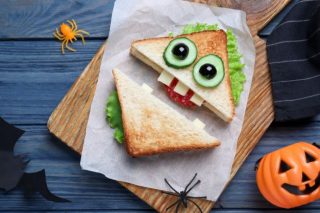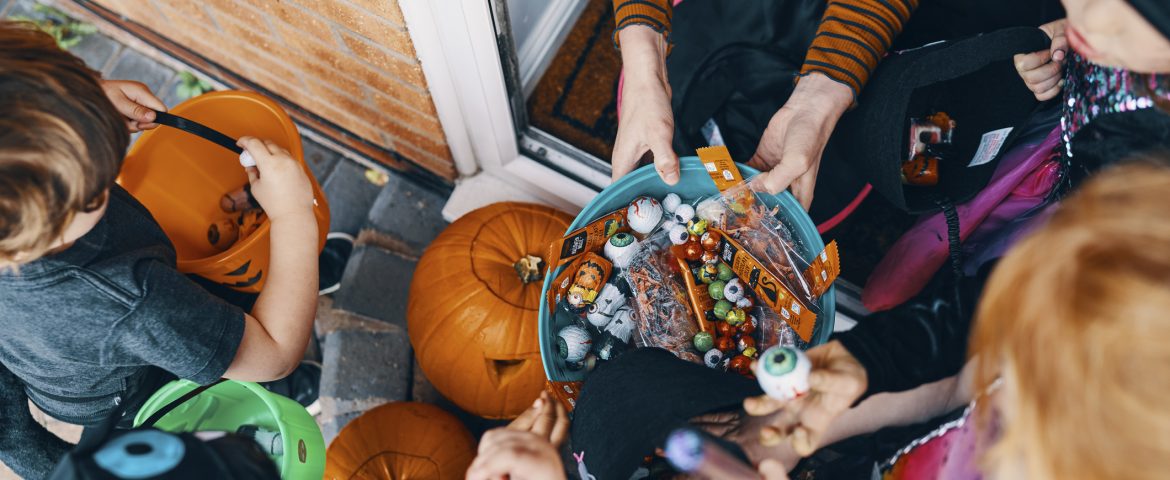By: Sophia Speroff, MPH, RD
About one in 13 children have food allergies, so it is important to understand how to keep Halloween fun – and safe – for all trick-or-treaters.
For children with food allergies, or those who just want to incorporate to a safer trick-or-treating experience, Priority Health has five tips for a belly-friendly Halloween:
1. Color Coded Pumpkins
Most trick-or-treaters are known for carrying an orange bucket to collect candy on Halloween. With Halloween buckets in mind, a few initiatives have opted to use different colors to signify different meanings. For example, a child carrying a teal bucket can signal that they have food allergies and are limited on what candies they can eat.  As part of the Teal Pumpkin Project, homeowners can also place a teal pumpkin on their doorstep to show that they will be giving out allergy-safe trinkets and treats. Similarly, purple pumpkins are often used to raise awareness for epilepsy. When a purple pumpkin is on display, it can mean that someone living at the house has epilepsy. Purple buckets can also signal that the child is epileptic. Knowing what the different colors on Halloween means is an easy way to make trick-or-treating more inclusive.
As part of the Teal Pumpkin Project, homeowners can also place a teal pumpkin on their doorstep to show that they will be giving out allergy-safe trinkets and treats. Similarly, purple pumpkins are often used to raise awareness for epilepsy. When a purple pumpkin is on display, it can mean that someone living at the house has epilepsy. Purple buckets can also signal that the child is epileptic. Knowing what the different colors on Halloween means is an easy way to make trick-or-treating more inclusive.
2. Healthy alternatives for Halloween treats
There are plenty of candy alternatives to pass out on Halloween, including organic raisins, fruit strips, apples, candied nuts, chips, hot chocolate mix packets, and popcorn packets. Consider passing out fun, non-food trinkets like glow sticks, stickers, bouncy balls, temporary tattoos, erasers, mini water bottles or bubbles.

For parents, avoid the temptation to fill up on just candy, parents can give their children a nutritious meal with healthy fats and protein before trick-or-treating. To continue with the festivities, give the dishes catchy, Halloween-themed names.
Have you heard of the “switch witch”? It’s a fun way to encourage kids to leave behind the unhealthy sweets in exchange for something even more exciting like money, toys, healthier foods or activities like play dough. There are many different approaches to the concept and you can make it your own based on your family’s needs.
3. Non-food related Halloween fun
To help avoid the disappointment of receiving foods your children can’t eat, skip trick-or-treating in the neighborhood and consider other festive activities. Halloween is not just about the candy! Carve a pumpkin, go on a scavenger hunt, play games, watch spooky movies or host a costume contest as the main event. Some restaurants give out free or discounted meals to costume wearers, check your local smoothie shop or orchard for activities.
Halloween is not just about the candy! Carve a pumpkin, go on a scavenger hunt, play games, watch spooky movies or host a costume contest as the main event. Some restaurants give out free or discounted meals to costume wearers, check your local smoothie shop or orchard for activities.
4. Prepare with your kids for trick-or-treating
For children with allergies, it might be helpful to set a few rules before they can enjoy their treats. Make sure they ask an adult to read the label before opening a piece of candy to ensure there are no harmful ingredients. You can also get them excited to learn what they should read for, kids enjoy taking charge! Sort all of their collected candies into separate piles so they know which are safe or unsafe to eat. Carry epinephrine auto-injectors or other medication along their treat-route in case an allergic reaction occurs.
5. Stay up to date on allergy testing
Allergies change over time and new technologies have allowed parents and healthcare providers to better understand food allergies. For example, different tests can provide insights into whether a child can tolerate baked or raw forms of milk and eggs. This could mean that some children may be able to enjoy Halloween cookies versus other candies. Candy ingredients can also change, so read the label first to make sure it’s still safe for a child to eat. Research allergy information and test your child if you have questions.
Be a safe and health food ally on October 31 (and always!). By taking a few simple precautions and staying watchful of which treats children eat, Halloween can still be enjoyable for the whole family.
About the Author: Sophia Speroff, MPH, RD is a Registered Dietitian of 10 years with her master’s in public health. Sophia has a tremendous background in both community and patient care and population health management. Her background also includes diabetes and chronic disease prevention and management, clinical dietetics, and wellbeing engagement in underserved communities. She has a passion for staying active, training for triathlons and half marathons and in her free time, Sophia enjoys hiking, folk dancing, and gardening.


